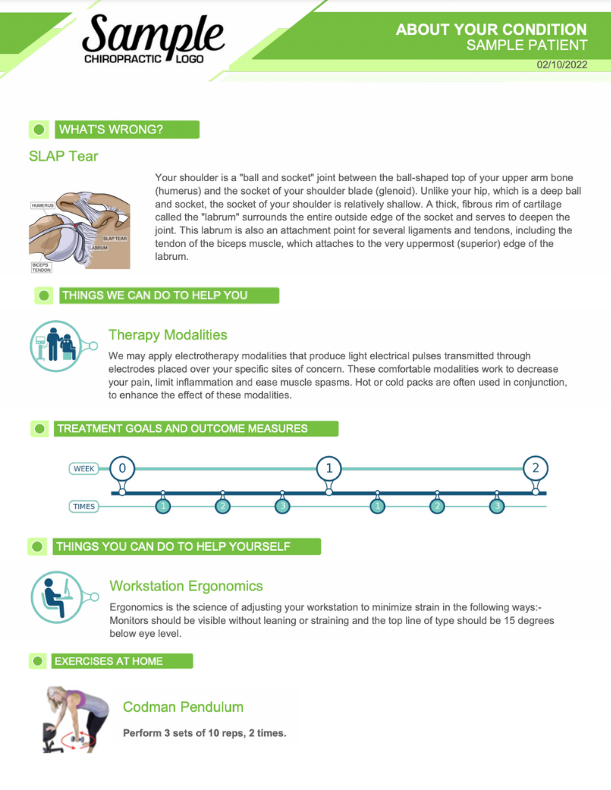3 Simple Tests for Identifying a SLAP Lesion
The acronym “SLAP” stands for Superior Labrum Anterior-Posterior. It describes a tear or detachment of the shoulder’s superior glenoid labrum, generally originating at the anchor site for the biceps tendon’s long head and extending into anterior or posterior portions of the labrum. This pathology is relatively common; up to 1/4 of patients undergoing shoulder arthroscopy will demonstrate a SLAP lesion regardless of initial diagnosis.
When Should I Suspect a SLAP Lesion?
SLAP lesions are common in athletic populations, particularly those requiring overhead motions that encourage the biceps to “pull” the labrum from its underlying bony attachment. Incidentally, the long head of the biceps has a dichotomous relationship with the labrum. In healthy shoulders, the biceps’ long head stabilizes the shoulder by generating compressive forces that limit translation, thereby protecting the shoulder from anterior subluxation. The biceps also depresses the humeral head to preserve the labrum and subacromial contents during arm elevation. Conversely, the biceps’ repetitive contraction may trigger the avulsion of its labral anchor – becoming progressively more problematic as the tear progresses.
Patients with a SLAP lesion can vary from asymptomatic to having disabling pain. Symptomatic patients often describe:
A deep, vague, non-specific shoulder pain worse with overhead or cross-body activity.
Weakness and stiffness
Discomfort limiting athletic performance, particularly in overhead athletes who complain of a “dead arm.”
Complaints of popping, clicking, grinding, or catches are common.
Patients with more advanced lesions are likely to report symptoms associated with instability; i.e. (pinching, slipping, apprehension, or “looseness”- especially during overhead activity)
Can Chiropractors Identify a SLAP Lesion?
Short answer – Yes. And here are 3 of the most sensitive and specific orthopedic tests for identifying a SLAP lesion. Proper chiropractic management is dependent on making the correct diagnosis. Here are three simple tests you can perform in-office to identify a SLAP lesion.
Can Chiropractors Treat a Slap Lesion?
In January, the Journal of Shoulder and Elbow Surgery concluded:
“non-operative treatment of superior labrum anterior-posterior (SLAP) tears in athletes can be successful, especially in the subset of patients who are able to complete their rehabilitation program prior to attempting a return to play.”(5)
The presence of a SLAP lesion does not automatically necessitate surgical intervention. Most experts, including the American Academy of Orthopedic Surgeons, recommend a 6-12 week course of conservative management before considering surgical intervention. (1-3)
Two-thirds of SLAP lesions will show symptomatic improvement via conservative care focusing on restoration of shoulder motion, rotator cuff balance, plus hip, core, and scapular stability. Check out this sample SLAP condition report and rehab plan.
For a complete guide to the chiropractic management and at-home rehab programs, subscribers can review the most up-to-date SLAP condition reference within ChiroUp.
While many SLAP patients improve via conservative care, a subset will require surgery; particularly those with an explicit traumatic episode and symptoms of instability. A recent publication by DeFazio et al. 2021 also highlights two important considerations for patients undergoing surgical intervention.
Post-surgical patients require rehabilitation to improve shoulder and scapular stability. Otherwise, 10% of patients require a second surgery due to re-tearing on the labrum.
Smoking increases the risk of re-tear due to the diminished capacity of tissue healing. (4)
Want to see more blogs like this one?
Subscribe to our weekly chiropractic blog! Written by chiropractors, for chiropractors.
Who Fails Conservative Management?
Non-operative treatment is the first line of treatment for most SLAP lesions. However, some factors negatively impact the success rate of conservative treatment: (5)
Older age
Participation in overhead sports (especially baseball pitchers)
Traumatic injury
Positive compression rotation test
Concomitant rotator cuff injury
Longer baseball career
Longer symptomatic period
Presence of a Bennett spur (calcification of the posterior band of the inferior glenohumeral ligament)
Conclusion
Successful chiropractic management of SLAP lesions requires proper diagnosis plus an optimal treatment plan. Use the above tests to recognize the diagnosis, then use the treatments in ChiroUp to help this demographic of patients in your office. And if you want to learn more about shoulder pain, here are some past blogs that you might find interesting.
Scapular Dyskinesis: https://chiroup.com/scapular-retraction-test-5-reasons-to-consider-this-modified-version/
Rotator Cuff Syndrome: https://chiroup.com/top-tests-to-quickly-accurately-diagnose-rotator-cuff-problems/
Chronic Shoulder Pain: https://chiroup.com/7-things-you-must-know-about-chronic-shoulder-pain/
ChiroUp is the leading online platform for evidence-based chiropractors.
-
Mileski RA, Snyder SJ. Superior labral lesions in the shoulder: pathoanatomy and surgical management. J Am Acad Orthop Surg. 1998 Mar-Apr. 6(2):121-31
Dodson CC, Altchek DW. SLAP Lesions: An Update on Recognition and Treatment. JOSPT February 2009, Volume 39 Number 2
Franceschi F, Longo UG, Ruzzini L, et al. No advantages in repairing a type II superior labrum anterior and posterior (SLAP) lesion when associated with rotator cuff repair in patients over age 50: a randomized controlled trial. Am J Sports Med 2008;36(2):247–53.
DeFazio, M.W., Özkan, S., Wagner, E.R. et al. Isolated type II SLAP tears undergo reoperation more frequently. Knee Surg Sports Traumatol Arthrosc (2021). Link




